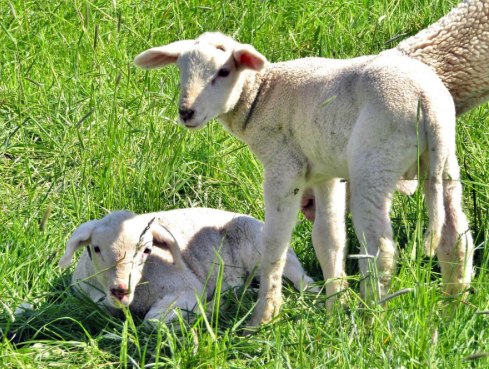
Mahatma Gandhi, the father of our country, referred goats and sheep as “poor man’s cows.” These small ruminants are easy to breed, requires less investment and yields higher profits for marginal farmers and landless labourers. Sheep and goats are popular because they may produce meat, milk, skin, offal, horn, dung for fire, wool, and fiber, among other things. The word “heat stress” refers to the discomfort and physiological strain due to the exposure of the animal to an extreme hot environment. For normal body function temperature should be maintained within a relatively narrow range, beyond which there is risk of organ dysfunction, and even death. The thermal environment that causes heat stress is a matter of concern that negatively influences livestock production and reproduction performance, growth, milk quantity and quality, as well as natural immunity, making the animals more susceptible to different diseases. The increasing demand for animal products paralleled by the frequent hot climate is a serious threat for the agriculture sector. In extreme environmental conditions, sheep and goat perform better than other ruminants. Sheep and goats adapt to extreme weather conditions via behavioral, morphological, physiological, and largely genetic basis. The goat and sheep breeds tend to tolerate heat better than other livestock species.But, despite their extreme tolerance, the productivity of these animals often declines due to heat stress. Therefore, proper breed selection and adoption of stringent managemental strategiescan sustain and augment animal production under an increasingly challenging environment.
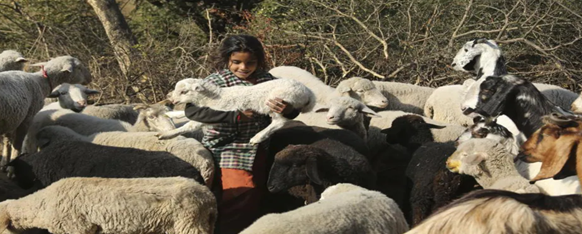
Effects of heat stress on feed and water intake of sheep and goat:
Interaction between stress and nutrition results in nutrient deficiency as HS is associated with marked reduction in feed intake. Feed intake decreases in heat-stressed animals in an attempt to create less metabolic heat. Change in the thermal environment induces a decrease of blood flow to the rumen (76% under severe stress and 32% under moderate stress) and reduction in both ruminal motility and rumination. It also lowers the dry matter intake in goats by 30%. Ultimately the body weight loss has been seen.
Likewise, small ruminants may experience moderate to severe water restriction during drought periods, when grazing in areas far from watering sources and their requirements for water in dry areas are high due to high temperature and radiation load from the sun. In general water deprivation for three days or more would have detrimental effects on feed intake by ewes which exhibited reduced milk production, body weight, jaw movements during rumination, respiratory rates and increased rectal temperatures. However, goats kept under HS conditions doubled their water consumption which facilitates heat loss by sweating and panting.
Effect of heat stress on productivity of sheep and goat:
A. Effect on milk quantity and quality:
HS decreases milk production of dairy animals, and half of this reduction in milk yield is due to reduced dry matter intake. During one experiment it was found that dairy goats kept under HS in a climatic chamber reduce their milk yield by 3–10%. The protein level and protein fraction also reduces in heat stress. Decreased protein intake and increased sweat secretion that contains protein and urea might have limited the availability of amino acids for milk protein synthesis. In contrast, milk fat contents did not differ between HS and control goats. Thus, milk of HS goats had different coagulation properties which could have an important impact on cheese industry.
B. Effect on meat quality and carcass characteristics:
High temperatures lead to dehydration in water deprived animals and this can affect meat quality by making it darker in, and because of its dryness it has less weight loss during cooking. Sheep and goats slaughtered under higher ambient temperature (35ºC) causes higher pH (5.78 vs. 5.65) level and lower color (lightness, redness and yellowness), and lowers juiciness than those slaughtered at lower temperature (21°C).
Effect of heat stress on reproduction and fertility of sheep and goats:
Summer HS is a major contributing factor to low fertility of domestic animals inseminated in the summer months. Effects of HS on fertility is more pronounced in lactating animals because the large amounts of heat produced as a result of lactation make it difficult to regulate body temperature during HS. Non-lactating animals and animals for meat purposes are much less likely to experience infertility during HS due to seasonal breeding patterns that ensure that animals are not bred at the warmest time of year, and relatively low amounts of metabolic heat production as compared to lactating animals. HS conditions drastically affect the sexual behavior, reduce the sexual activity and in turn reduce sperm quality, sperm production and motility, resulting in poor conception by reducing testosterone (hormone) level.
Methods for heat stress mitigation:
From above information it can be said that heat stress adversely affects the small ruminants i.e. sheep and goat in various ways that ultimately leads to production loss and economical loss. Therefore, a variety of methods should be adopted by small ruminant\owners to overcome the negative effects of HS like.
Use of shades:
Shade is the easiest method to reduce the impact of high solar radiation, and it is applicable under extensive conditions. The use of shades, fans or evaporative cooling should be provided which is not possible in semi-intensive systems as sheep and goats are grazed in the open during most of the day, and this necessitates other strategies like portable shades. Providing sheep and goats access to shade leads to improvements in weight gain, milk production and reproductive performance. A well-designed shade structure reduces heat load by 30–50%. Shelters do not need to be complicated or elaborate, trees and shrubs can serve as shelters for animals from solar radiation which is a very good cost alternative.
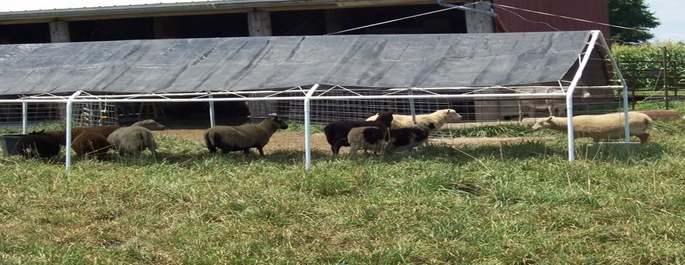
Ration modifications:
- Grazing hours: Changes in feeding schedules that includes feeding at cool hours
- Ration composition: Feed containing low fiber rations during hot weather should be given as it reduces the metabolic heat production. More nutrient-dense diets are usually preferred during the HS period. In dairy goats 4% fat supplement during summer lowers rectal temperature. Soybeanoil fed to goats in HS conditions, increases milk fat content.
- Feed additives: antioxidants such as vitamin C and E supplementations decreased rectal temperature and respiration rate in sheep and goat.
- Water: The water requirements of sheep and goats increase under HS conditions; thus, it is essential that animals have a continuous access to adequate, clean, cool and fresh water.
- Minimize handling time: Handling animals should be kept at minimum. Sheep and goats can be handled in the early morning or late evening time during milking, transportation, and the afternoon work should be avoided when body temperature is already high. Delay the afternoon milking for 1-2 hours.
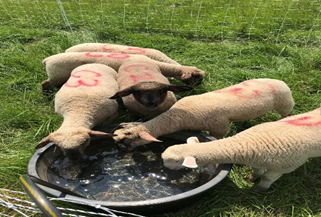
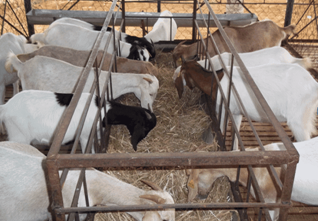
Fig: Feed and water management in sheep and goat during heat stress
Housing management:
Proper selection of site of house with minimal radiation, air temperature and humidity, and maximal air velocity will help in mitigation. Adequate space allowance, feces accumulation management and continuous and careful monitoring in terms of temperature, relative humidity and air quality are crucial aspects in sheep and goat housing. In addition, fully enclosed shelters are not recommended for hot climates because of the decreased natural air velocity, therefore, it is preferred to use partially enclosed shelters. Cooling sheep and goats by spraying could reduce HS symptoms and improve animal welfare. Direct wetting of animals is often used as an emergency measure and can be an effective and can increase the milk production and feed intake in sheep and goat.
Conclusion:
Sheep and goat farming is the main source of income with the lesser investment for the marginal farmers. So, it is important to maintain good health of these animals. Heat stress is being the major factor affecting the production and reproduction of the animals. Various effects of stress have been seen on behavior like shade seeking behavior, panting in order to reduce heat stress. It also reduces the productivity of sheep and goat i.e. reduce their milk yield by 3–10% as well reduces the quality of meat. Reduction in dry matter intake and lower water availability will ultimately lead to reduction in the production. Heat stress reduces the sperm quality and reproductive ability of the animal. Mitigation can be done by various providing proper shade, providing good amount of water in summer, feeding lo fiber and high fat feed. Addition of feed additives like vitamin C and vitamin E would also help in reducing heat stress. Maintenance of proper ventilation and temperature in the animal house will also help in heat stress management.
Moreover, spraying water during hot hours on animal helps in the mitigation. It is important to take care and proper management of the animal during summer period to reduce the incidence of heat stress in order to reduce the productivity, reproductivity loss and ultimately to reduce economical loss to the marginal farmers.

Nishtha Kushwah
PhD Scholar, Animal Physiology Division, ICAR-NDRI, Karnal, Haryana

















